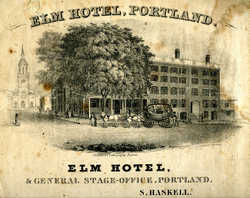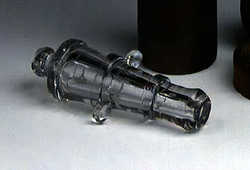
Cartoon, Portland Watch or Cracking Notes, ca. 1840
Maine Historical Society
Portland Watch or Cracking Notes, ca. 1836
Joseph T. Harris (active 1828-1852)
pen on parchment
Collections of Maine Historical Society; gift of Philip Isaacson
This remarkable cartoon recalls one of many late night affrays between troubadours Frederic Mellen, Seth Paine, A.H. Jenks, artist H.T. Harris, and various constables, citizens and sailors, near Portland's St. Paul's Church. In the 1830s, young college students, artists, and friends spent the wee hours singing in front of houses until they were paid to go away. According to the Eastern Argus of August, 1836, "A Correspondent who signs himself Ben Pump complains of the serenades of the Night Band, and expresses a willingness to turn out and help put its members in a horse pond. We have no objections."

Alcoholometer set by Charles Gerletti of Glasgow, made 1834-1839
Maine State Museum
Proof Set, early 19th century
Charles Gerletti, Glagow,
Etched glass in wooden box
Collections of Maine State Museum, purchased with funds from the Lewis J. Sheaffer Charitable Unitrust for the Katharine Hazzard Sheaffer Glass Collection.
This set was used to test the proof in alcoholic beverages. Each bead is etched with a number, when the bead sank, it indicated the level proof of the alcohol.
Ginger Beer Bottle, ca. 1825-1850
Bourne, Denby, England
Stoneware
Collections of Dyer Library / Saco Museum
Increasingly soft drinks were becoming the favorite beverage of middle class America. Bottles were made in England and importers like Josiah Russell filled them with ginger beer from the West Indies.

Hampden House Bar, 1837
Maine Historical Society and Maine State Museum
Hampden House Bar, 1840
John Martin (1823-1904)
Watercolor and pen and ink hand-illustrated journals
Collections of Historical Society and the Maine State Museum
Professional bartender John Martin created this wonderful watercolor of a fully stocked bar at the Hampden House Hotel in 1840.The Mahogany paneled bar held cut glass decanters. A brass urn, heated with charcoal, was kept hot to make warm Tom and Jerrys, a rum drink.The upper shelf contains cigar boxes, represented by red squares. On the top were champagne and wine bottles with apples for stoppers. Liqueurs, goblets, and wine glasses had oranges and lemons placed on them.
"Selling liquor even in a respectable house was not the business for me to start as a young man desiring the best wishes of the best people." - John Martin
Elm Hotel Broadside, ca. 1840
Fitz Hugh Lane (1804-1865)
Collections of the Portland Public Library Special Collections and Archives
The Elm Hotel located at the corner of Portland's Federal and Temple streets, just below the First Parish Meetinghouse, was a stagecoach depot and popular watering place for the likes of critic John Neal and artist Charles Codman. Beginning in 1824, liquor laws were tightened so taverns were licensed to sell drinks only to be consumed on premises.
Decanter
English, 1850-1860
Blown and cut glass; silver mount engraved Morse
Collections of Victoria Mansion: The Morse-Libby Mansion; gift of Mr. and Mrs. Daniel J. Libby
Wineglasses and Champagne flute
Attributed to the New England Glass Company, Cambridge, Massachusetts, ca. 1860
Blown, cut, and engraved glass; engraved with the initial M
Collections of Victoria Mansion; The Morse-Libby Mansion
This glassware represents the finest available in mid-nineteenth-century America. It graced the extraordinary residence of Ruggles Sylvester Morse on Danforth Street in Portland. Built in 1858–1860, the Morse-Libby Mansion (known as Victoria Mansion) survives as a virtual time capsule of pre-Civil War grandeur.
Morse made his fortune operating luxury hotels in New Orleans during the 2nd half of the 19th century. A major part of an hotelier's job was to maintain a fine wine cellar. Indeed, many of a hotel's profits were realized from the sale of alcoholic beverages, as these libations were not included in the cost of lodging. A bottle of the wines of the choicest brands that Morse stocked cost as much as an overnight stay and meals combined.
Morse's experience carried over into his home where hotel amenities can be found. For instance, Morse's Portland house had a fabulous wine cellar. His drinking glasses, noted for their fine quality, were blown, cut, and engraved with scenes depicting animals in landscapes. This decoration is in the Bohemian style, but the ware is attributed to an important New England factory. This glassware would have been very expensive at the time. As luxury objects they would have greatly enhanced a diner's experience as he made his way through the multiple courses served during meals with Madeira, Burgundy, clarets, sauternes, Champagnes, Ports, and French liqueurs.

Casco Engine Co. No. 1, Portland, 1846
Maine Historical Society
Casco Fire Company, ca. 1849
Middle Street near Exchange
Daguerreotype
Collections of Maine Historical Society
Militia and fire musters such as these were cause for heavy drinking and rowdyism. In 1827, Neal Dow made some of his first converts to prohibition while serving as the clerk of the Deluge Fire Company.
Wine Taster in the form of a cannon, 1815-1830
England
Courtesy of Arlene Palmer Schwind
This novelty-shaped wine taster was used to sample the wine as it fermented.

Diamond Cove, Great Diamond Island, ca. 1836
Maine Historical Society
Diamond Cove, ca. 1836
Charles Codman (c. 1800-1842)
Oil on canvas
Collections of Maine Historical Society; gift of Gertrude A. Phelan, 1918
Following the War of 1812, the recovering economy and a new spirit of optimism made leisure activities affordable and popular. Diamond Cove on Great Hogg Island became the focus of numerous picnic parties, which were celebrated by poets and painters. The Deering farm on the island included a cider press.
Wine Caster for a traveling case, ca. 1875-1900
American
Cut glass
Collections of Maine Historical Society; gift of Mrs. Edward McClure Peters
497*
This set, which fits inside a wooden case, would have been used for elegant picnics and for traveling. It was owned by a Portland doctor and his family.
Coaster
American, probably New York, 1855-1860
Silver and birds eye maple; silver engraved Morse
Collections of Victoria Mansion: The Morse-Libby Mansion; gift of Mr. and Mrs. Daniel J. Libby
Photography by J. David Bohl







